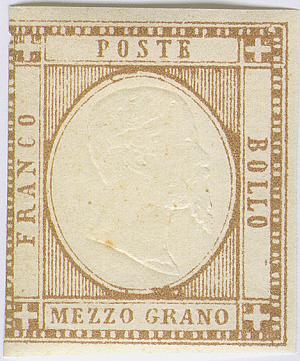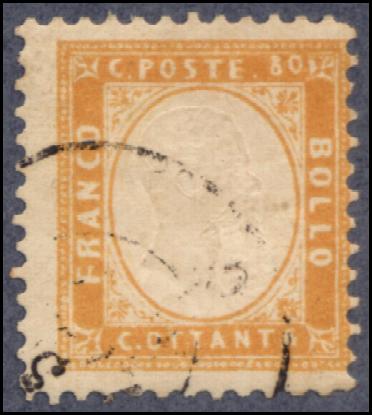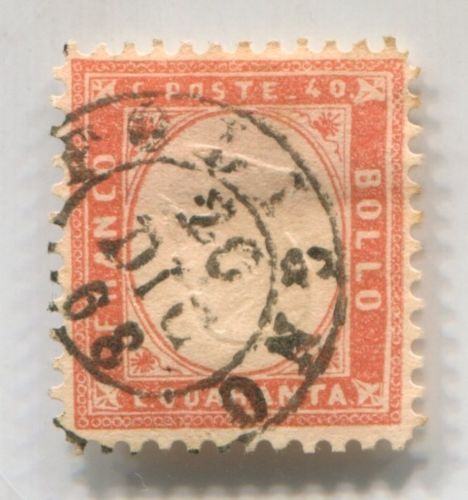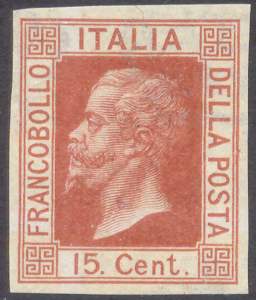








Return To Catalogue - Italy overview - Sardinia
Note: on my website many of the
pictures can not be seen! They are of course present in the cd's;
contact me if you want to purchase them: evert@klaseboer.com.
The earliest Italian stamps did often only have the value written on it, the following table gives the meaning of the value inscription:
| 1/2 = Mezzo | 1 = Un | 2 = Due | 5 = Cinque |
| 10 = Dieci | 15 = Quindici | 20 = Venti | 25 = Venticinque |
| 30 = Trenta | 40 = Quaranta | 50 = Cinquanta | 60 = Sessanta |
1/2 (Mezzo) t green 1/2 (Mezzo) g brown 1 (Un) g black 2 (Due) g blue 5 (Cinque) g red 10 (Dieci) g orange 20 (Venti) g yellow 50 (Cinquanta) g grey (or blue)
Similar stamps were issued in Italy. Some of these stamps exist with inverted center.
Value of the stamps |
|||
vc = very common c = common * = not so common ** = uncommon |
*** = very uncommon R = rare RR = very rare RRR = extremely rare |
||
| Value | Unused | Used | Remarks |
| 1/2 t | ** | R | |
| 1/2 g | R | RR | |
| 1 g | R | *** | |
| 2 g | ** | ** | |
| 5 g | *** | R | |
| 10 g | *** | R | |
| 20 g | R | RR | |
| 50 g | R | RRR | |
Typical cancels:
I have my doubts about the following two stamps, the embossed center is inverted, forgeries?

A stamp of Sardinia with the same '1884' forged numeral cancel as
shown above

A highly suspicious Sicily cancel on a 10 g stamp

Forged cancel on genuine stamp

The words 'DUE GRANA' are written much smaller than in the
genuine stamps in this forgery. The corner crosses are way too
large.










Forgeries made by the same forger? The lettering is completely
different from the genuine stamps. Many of them have the cancel
'NAPOLI 16 MAGG 61 12 M' or 'NAPOLI 19 MAGG 61 12 M'.

Forgery of the 2 g with different lettering, made by the same
forger? Reduced size
I know that Sperati also has made forgeries with inverted head. He bleached out the design of a genuine stamp, leaving the embossed center intact and then printed a new design, inverted, on top of it. In this way the experts were fooled; they tried to establish if the embossing was genuine (and it is in these forgeries!). Examples of these forgeries can be found at: http://www.seymourfamily.com/rfrajola/Sperati/speratiindex.htm, :

(Sperati forgery, image obtained from Richard Frajola's website)


Front and backside of a Sperati reproduction
In the above Sperati forgeries, there is a small
break in the outer frameline, just above the 'S' of 'POSTE'.
There is also a break in the line below in front of the 'T' of
the same word. Finally, there is a break in the line just above
the front of the 'E' of 'DUE'. This forgery exists on letters.
Sperati also made forgeries of a 2 g black misprint (with the
same distinguishing characteristics as the 2 g blue Sperati
forgery).
Other forgery with 'FAUX' (=forgery in French) overprint:

(Could this be a Fournier forgery?)

Page from a 'Fournier Album of Philatelic Forgeries' with forged
2 g, 5 g and 50 g stamps, also a cancel "NAPOLI 12 AGO 61 8
S" in a single circle that was probably used on these
forgeries.

Part of a Fournier Album.

10 g black (wrong colour); probably a forgery

Other item I don't quite trust

A 'reprint' made for the 'Salon der Philatelie' in Hamburg 1984
of the 1/2 t value
A number of postal forgeries exist (to deceive the post office). There is one postal forgery of the 5 g value, two of the 10 g value and one of the 20 g value. Example:

Postal forgery of the 5 G value.

(Postal forgery, image obtained from Lorenzo)
In the above postal forgeries of the 10 g, the crosses in the corners are not symmetrically. In the genuine 10 g stamp, there are 12 pairs of white dots at the bottom and at the top, 15 pairs of white dots at the left and 14 pairs at the right. This postal forgery has 13 pairs of dots at the bottom and 15 at the top. I've only seen them with the cancel 'NAPOLI PORTO' used in March 1862.

I've been told that this is a postal forgery of the 20 g value. I
have no further information.
10 c brown 20 c blue 40 c red 80 c yellow
The perforation of these stamps is 11 1/2 x 12. They were printed in sheets containing 50 stamps.
Value of the stamps |
|||
vc = very common c = common * = not so common ** = uncommon |
*** = very uncommon R = rare RR = very rare RRR = extremely rare |
||
| Value | Unused | Used | Remarks |
| 10 c | RRR | R | Issued 24 February 1862 |
| 20 c | * | *** | Issued 1 March 1862 |
| 40 c | R | R | Issued 10 April 1862 |
| 80 c | * | RR | Issued 3 October 1862 |
Imperforate
15 Centesimi blue
This stamp was printed in sheets of 50.
Value of the stamps |
|||
vc = very common c = common * = not so common ** = uncommon |
*** = very uncommon R = rare RR = very rare RRR = extremely rare |
||
| Value | Unused | Used | Remarks |
| 15 c | *** | *** | Issued 1 January 1863 Inverted center: RR |
The 5 c green was never issued perforated (only imperforated for Sardinia), but reprint-forgeries made by the forger David Cohn exists of this stamp with perforation:
For more information on these 'reprints' see under Sardinia.


Forgeries of the 40 and 80 c values, the '40' and '80' are done
very badly. Similar imperforate forgeries exist for Sardinia.

Forgery with inverted head and the "FOLIGNO 20 DIC 68"
cancel which can be found in the Fournier Album

Fournier album of the Papal States, with the forged 'FOLIGNO 20
DIC 68' cancel.

15 c blue
Specialists distinguish two types of these stamps. In type I, the line below the word 'QUINDICI' is close at the 'Q'. In type II, there is a break just below the 'Q'. Type I was issued on 10 February 1863. Type II was issued in April 1863. Both types were printed in sheets of 50.
Value of the stamps |
|||
vc = very common c = common * = not so common ** = uncommon |
*** = very uncommon R = rare RR = very rare RRR = extremely rare |
||
| Value | Unused | Used | Remarks |
| 15 c | c | * | Issued 10 February 1863 Type I: R |
I've seen printer's waste with the impression on both the front and backside.

Printer's waste with double impression
Forgeries exist of the rare type I, examples:

I've been told that the above stamp is a forgery. It might be one of the modern forgeries of Italy that are often offered together with forgeries of the Italian States. According to http://www.italianstamps.co.uk/kingdom/matraire/index.html, this forgery is quite common but has the lettering too neat.

This forgery was even pasted on a letter on an old letter.
According to the book: 'Postal Forgeries of the World' by H.G.L. Fletcher, a postal forgery exists. This postal forgery has a very long upper parts of the 'T' and especially the 'E' of 'POSTALE'.
5 c green 10 c brown 10 c blue (1877) 15 c blue 20 c blue (1876) 20 c orange (1877) 30 c brown 40 c red 60 c violet 2 L red Surcharged (1865)

20 c and bar on 15 c blue
For the specialist, these stamps have perforation 14 and watermark 'crown':

(Watermark crown)
Value of the stamps |
|||
vc = very common c = common * = not so common ** = uncommon |
*** = very uncommon R = rare RR = very rare RRR = extremely rare |
||
| Value | Unused | Used | Remarks |
| 5 c | *** | c | |
| 10 c brown | R | c | |
| 10 c blue | RR | c | |
| 15 c | RR | c | |
| 20 c blue | *** | c | |
| 20 c orange | RR | c | |
| 30 c | ** | c | |
| 40 c | RR | c | |
| 60 c | *** | * | |
| 2 L | *** | *** | |
| 20 c on 15 c | ** | c | Three types exist of this overprint |
Overprinted 'ESTERO' for use in the Italian post offices in the Levant, click here, (slightly different design).

Fournier forged overprints, image taken from a 'Fournier Album of
Philatelic Forgeries' (reduced size)
I have seen some of these stamps (15 c, 30 c, 40 c, 50 c and 2 L) with the cancel removed in order to make them appear 'uncancelled'.
Numeral cancels exists in two types: 1) dots type; used from 1866 to 1877. 2) line type; used up to 1889. The numbers 3101 onwards only exist as the line type cancel. See also http://www.alneum-resources.com/resources/numitaly.html.


Numeral dot cancel (left) and numeral line cancel (right); both
reduced sizes
Some numeral cancels and their corresponding town
are:
1) Allesandria
2) Ancona
3) Bari
4) Bergamo
5) Bologna
6) Brescia
7) Calgliari
8) Catania
9) Como
10) Cremona
11) Ferrara
12) Firenze
13) Genova
14) Livorno
15) Lucca
16) Messina
17) Milano
18) Modena
19) Napoli
20) Novara
21) Palermo
22) Parma
23) Pavia
24) Perugia
25) Piacenza
26) Pisa
27) Siena
28) Torino
189) Torino (railway)
206) Roma
207) Roma (railway)
4473) Tarsogno

(Stamp of Italy used in Marseilles, France with French numeral
cancel)
Essays of this issue:

So-called 'Essay Bigola', 15 c red, I've seen this same essay in
grey and blue (both 15 c)

Essay Grazioli of the 1863 issue; I've also seen the values 10 c
red, 10 c brown and 10 c black on green.





More essays of the 1863 issue, I've seen the 40 c in the colour
green and the 60 c in the colour black on yellow.

A 'Wentch-Essay' of the 1863 issue

A bogus issue? inscription 'NEO REGINA 1870 CINQUANTA CENTESIMI',
resembling the above issue